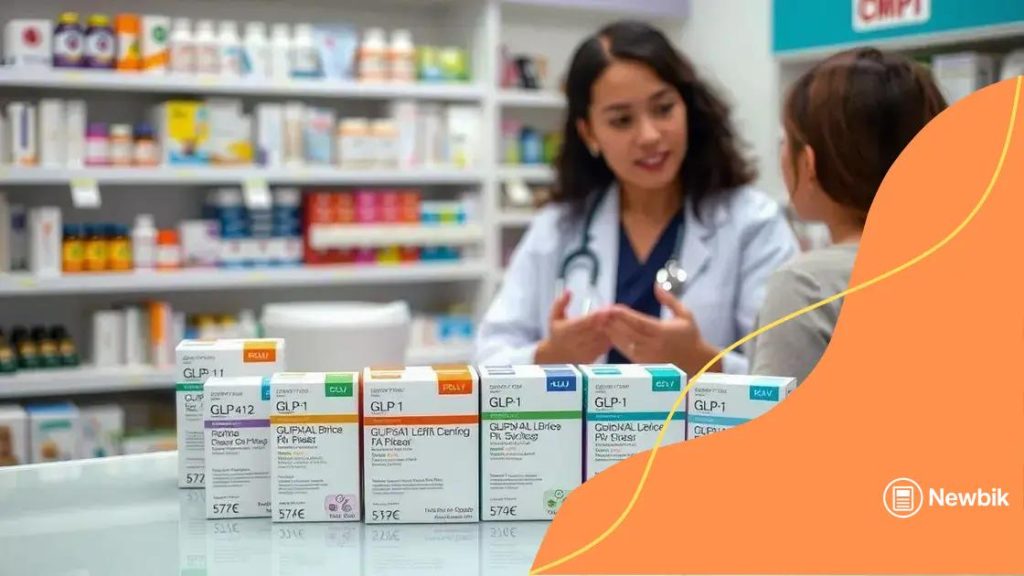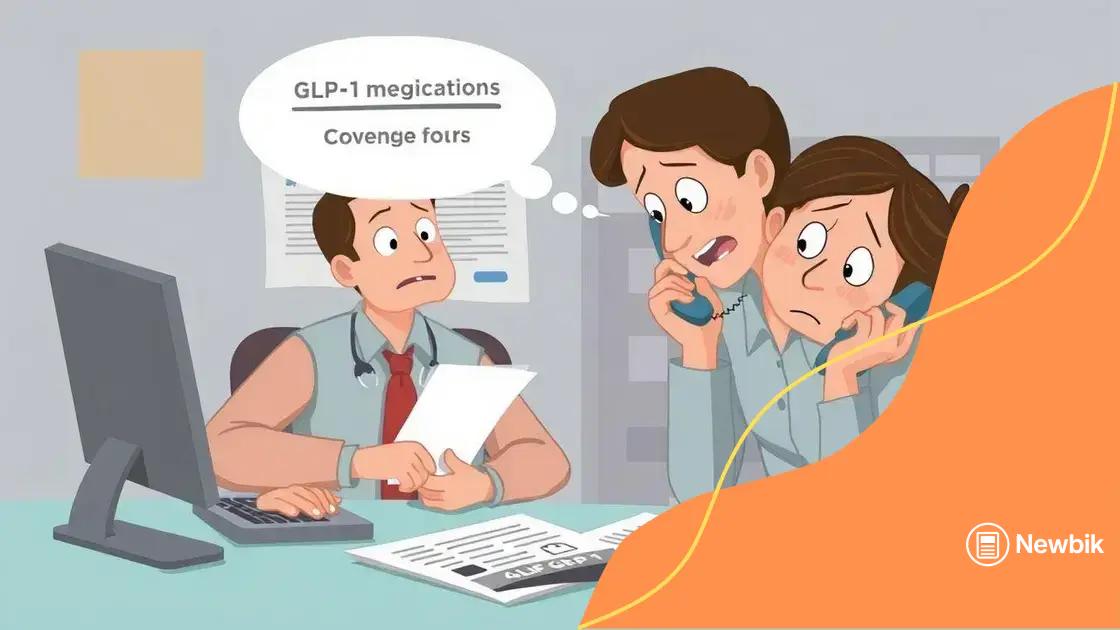Insurance and access issues related to GLP-1 medications

Insurance and access issues related to GLP-1 medications often involve high costs, strict prior authorization, and limited coverage, making it challenging for patients to obtain necessary treatments.
Insurance and access issues related to GLP-1 medications are more common than you might think. Many individuals find that navigating the insurance landscape can complicate treatment options. Have you ever wondered how these barriers affect your health journey?
Understanding GLP-1 medications and their benefits
Understanding GLP-1 medications is essential for anyone considering these treatments for weight management or diabetes. These medications help regulate insulin and control blood sugar levels, offering significant health benefits.
Many people may wonder how these medications actually work. Let’s explore their benefits.
Key Benefits of GLP-1 Medications
GLP-1 medications provide a range of advantages:
- They promote weight loss, which can reduce the risk of obesity-related conditions.
- They improve glycemic control by stimulating insulin secretion when glucose levels are high.
- They slow gastric emptying, helping you feel fuller for a longer time.
Furthermore, studies have shown that these medications can also lower the risk of cardiovascular diseases. By managing both heart health and weight, individuals can significantly enhance their overall well-being.
For those struggling with diabetes, GLP-1 medications represent a new avenue for treatment. They are usually prescribed alongside lifestyle changes, such as diet and exercise. This dual approach can lead to better health outcomes.
How GLP-1 Medications Differ
Not all GLP-1 medications are the same. Each drug within this class has unique features:
- Some are administered daily, while others require weekly injections.
- They may have different side effects, which can affect patient preferences.
Therefore, it’s crucial to work with a healthcare provider to find the right option for you. Together, you can weigh the pros and cons of each medication and how it fits your lifestyle.
The role of insurance in accessing GLP-1 medications
The role of insurance in accessing GLP-1 medications is a critical factor for many patients. Without proper coverage, these essential treatments can be out of reach for those who need them most.
Understanding how insurance plans work is vital for patients and healthcare providers alike. Each insurance provider has different policies regarding drug coverage, especially for newer medications like GLP-1s.
Insurance Coverage Challenges
Many patients face obstacles when trying to obtain insurance coverage for GLP-1 medications. Common challenges include:
- Strict prior authorization requirements that delay access.
- High copayments that make medications unaffordable.
- Limitations on the types of GLP-1s covered by certain plans.
These challenges can lead to frustration and even abandonment of treatment. It’s essential for patients to advocate for themselves and understand their insurance plans thoroughly.
Some insurance plans might offer limited coverage for these medications. Many patients are unaware that some programs provide assistance for those who qualify. This can significantly reduce costs and provide better access to necessary treatments.
Tips for Navigating Insurance Issues
To navigate the complexities of insurance effectively, consider the following tips:
- Review your insurance policy to understand the specifics of coverage for GLP-1s.
- Contact your insurer to ask about coverage criteria and any potential assistance programs.
- Work closely with your healthcare provider to submit necessary documentation for prior authorization.
By being proactive and informed, patients can improve their chances of successfully obtaining the medications they need.
Challenges faced by patients in obtaining coverage

Patients often face significant challenges when trying to obtain coverage for GLP-1 medications. These obstacles can vary widely depending on the individual’s insurance plan and local healthcare regulations.
Understanding these challenges is crucial for effective advocacy. Many individuals find that their insurance companies impose strict rules on medication coverage, particularly for new or expensive treatments.
Common Challenges Encountered
Among the most common issues are:
- High out-of-pocket costs that make medications unaffordable.
- Prior authorization requirements that delay access to necessary drugs.
- Limited formularies that exclude certain GLP-1 medications.
These barriers can lead to interrupted treatment plans, causing stress and health concerns for patients. Many individuals may feel overwhelmed when trying to navigate these processes.
Furthermore, some patients discover that their clinician’s recommendations are not covered under their insurance. This disconnect can create confusion and further delay access to needed medications.
Tips for Overcoming Coverage Challenges
Patients can take proactive steps to address these challenges:
- Contacting their insurance company to clarify coverage details and requirements.
- Requesting a coverage exception if their medication is not on the formulary.
- Working with healthcare providers to ensure that all required documentation is complete.
By staying informed and active in addressing these issues, patients can improve their chances of obtaining the coverage they need for GLP-1 medications.
Alternatives for those struggling with insurance issues
For patients facing challenges with insurance coverage for GLP-1 medications, seeking alternatives can be a vital step toward effective treatment. It’s crucial to explore different options that may alleviate the burden of high costs and coverage issues.
One alternative many consider is looking into patient assistance programs. These programs may be offered by pharmaceutical companies to help patients access their medications at reduced costs or even for free.
Exploring Patient Assistance Programs
Many pharmaceutical companies provide assistance in various forms, including:
- Discount cards that can lower the cost at pharmacies.
- Application programs that help qualifying patients receive medications at no cost.
- Information on co-pay assistance and savings programs available for patients.
Another option includes exploring community health centers, which can provide medical services at reduced costs. These centers may offer comprehensive care, making it easier to receive medications alongside other critical services.
Additionally, some patients may find success by talking to their healthcare providers. They can offer guidance on how to navigate insurance policies or suggest alternative medications that are more likely to be covered.
Utilizing Support Networks
Support networks can also be instrumental in exploring alternatives. Online forums and local support groups often share valuable resources. Here are some options:
- Online communities focused on diabetes or weight management that share personal experiences and advice.
- Non-profit organizations that advocate for patient rights and may provide resources for insurance navigation.
- Social media groups where members exchange tips and resources regarding GLP-1 medications.
By staying informed and leveraging available resources, individuals can find pathways to access GLP-1 medications, even in the face of insurance challenges.
Future trends in GLP-1 medication accessibility
The future trends in GLP-1 medication accessibility are shaping up to be increasingly positive for patients in need. With the growing understanding of diabetes management and weight loss, more stable options are expected to become available.
As research continues, new formulations and delivery methods may emerge. These innovations could lead to improved accessibility and affordability for patients.
Emerging Trends
Some key trends to watch include:
- Increased insurance coverage for GLP-1 medications as their effectiveness becomes more widely recognized.
- Development of oral formulations, making it easier for patients to adhere to treatment plans.
- Expansion of patient assistance programs to support lower-income individuals seeking access.
Moreover, advancements in technology could allow patients to monitor their health more effectively. Smart devices and apps are making it easier to track medication adherence, dietary habits, and blood glucose levels.
As more data is collected on the effectiveness of GLP-1 medications, policymakers may push for broader healthcare reforms. These reforms could aim to ensure that essential medications are available to all, regardless of insurance status.
The Role of Advocacy
Patient advocacy groups are likely to play a crucial role in this evolution. They can help raise awareness about the necessity of GLP-1 medications and advocate for policies that improve access. Their efforts can lead to legislative changes that promote equity in healthcare.
As awareness of diabetes and obesity issues grows, more stakeholders may begin to collaborate in finding solutions. This could lead to increased visibility and funding for programs that support access to GLP-1 treatments.
FAQ – Common Questions About GLP-1 Medications and Accessibility
What are GLP-1 medications used for?
GLP-1 medications are primarily used to manage type 2 diabetes and assist with weight loss by regulating blood sugar levels and promoting satiety.
How can I access GLP-1 medications if my insurance doesn’t cover them?
Patients can explore patient assistance programs offered by pharmaceutical companies, look for community health centers, or consult their healthcare provider for alternative medications that may be covered.
What challenges do patients face in obtaining these medications?
Common challenges include high out-of-pocket costs, strict prior authorization requirements, and limitations in insurance formularies that may exclude certain GLP-1 medications.
What trends are expected to improve accessibility in the future?
Future trends may include increased insurance coverage for GLP-1 medications, the development of oral formulations, and expansion of patient assistance programs to help more individuals gain access.